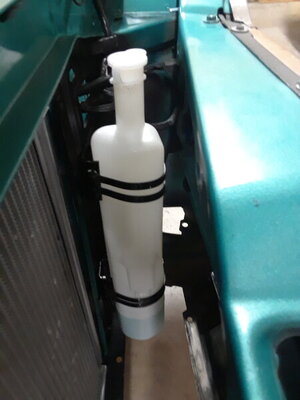So I filled the radiator up on the 440, only to find out it leaked. I took the radiator to the radiator shop that has been around at least 60 years and got some advice too. According to him, I should use a 7 to 10 pound radiator cap and have an overflow bottle or better yet, a recovery system. He said, ‘use anything that will hold fluid. I have even used a beer can before. Remember, 7 to 10 pound cap, 10 max.’ So that is what I did.
Some may disagree with his assessment, but I chose to listen since he and his family has been doing this forever. I would like to hear opinions on the ’10 pound max’ though.
Anyway, I had started thinking about that months ago and started poking around to see what is available. For anywhere from $10 to $100 or much more, you could buy something that would look cool and maybe function, who knows. In my garage I ran across a windshield washer reservoir out of my old 78 Chevy pickup. It would fit on the driver’s side between the radiator and fender, but still that was a little concerning. I mean who the hell wants a Chevy part on your precious MOPAR??? Well, that would be me. But while screwing around with the power steering pump and pulley, I discovered a treasure trove of space under the battery. So now I can have a Chevy part on my roadrunner and nobody will see it and laugh at me. Plus, it should function well too.
So I just cut a piece of sheet metal three inches wide and eight inches long, bent lips on both ends and mounted it. There is a hole in the radiator support (guess that is what it is called), drilled a hole in the newly invented ‘box’ and screwed a bolt in. I mounted the windshield wiper bottle in it, connected hoses, now the repurposed windshield washer bottle has been reborn as a ‘coolant recovery system’. He is so proud.
So I drilled two holes in the top of the bottle for the hoses. The one was a 3/8 and the other a ¼ I believe. Then inserted grommets and the recovery hose to the radiator and via the grommet. Inserted an overflow hose in the smaller grommet and ran it down the radiator to drain underneath. I inserted the recovery hose at a depth of about two inches and the recovery hose to the bottom.
Anyway, cheap and easy. The only downside is it is under the battery. If I want to add fluid to the recovery system, the battery has to be removed. No big deal, takes a minute. After the engine is started and run for a cam break in, I will remove the battery and pour a half pint or so coolant it as it is only a three pint bottle.
Below are pictures of this fabulous invention that probably has been invented before. But hey, we cannot have enough ingenuity!!!
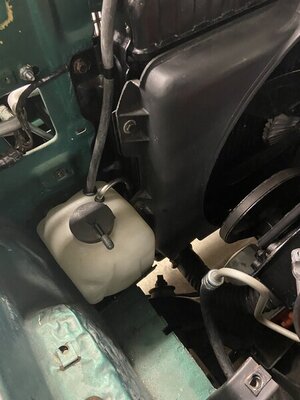
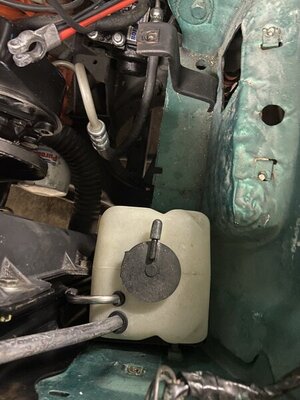
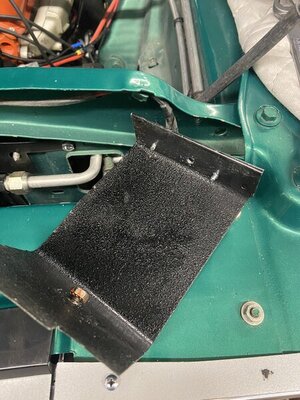
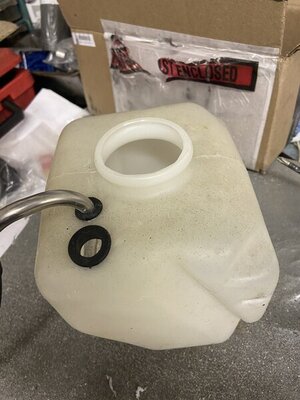
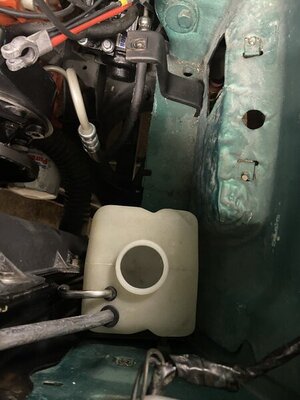
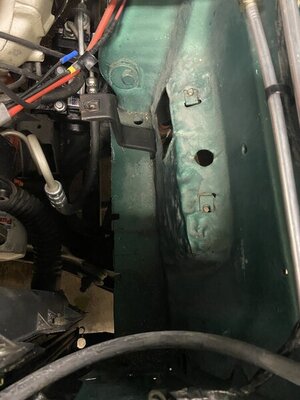
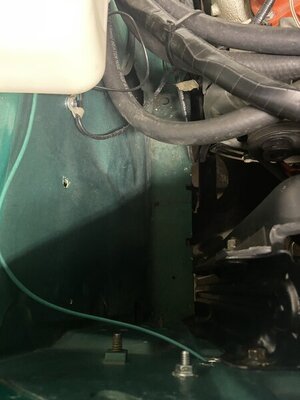
Some may disagree with his assessment, but I chose to listen since he and his family has been doing this forever. I would like to hear opinions on the ’10 pound max’ though.
Anyway, I had started thinking about that months ago and started poking around to see what is available. For anywhere from $10 to $100 or much more, you could buy something that would look cool and maybe function, who knows. In my garage I ran across a windshield washer reservoir out of my old 78 Chevy pickup. It would fit on the driver’s side between the radiator and fender, but still that was a little concerning. I mean who the hell wants a Chevy part on your precious MOPAR??? Well, that would be me. But while screwing around with the power steering pump and pulley, I discovered a treasure trove of space under the battery. So now I can have a Chevy part on my roadrunner and nobody will see it and laugh at me. Plus, it should function well too.
So I just cut a piece of sheet metal three inches wide and eight inches long, bent lips on both ends and mounted it. There is a hole in the radiator support (guess that is what it is called), drilled a hole in the newly invented ‘box’ and screwed a bolt in. I mounted the windshield wiper bottle in it, connected hoses, now the repurposed windshield washer bottle has been reborn as a ‘coolant recovery system’. He is so proud.
So I drilled two holes in the top of the bottle for the hoses. The one was a 3/8 and the other a ¼ I believe. Then inserted grommets and the recovery hose to the radiator and via the grommet. Inserted an overflow hose in the smaller grommet and ran it down the radiator to drain underneath. I inserted the recovery hose at a depth of about two inches and the recovery hose to the bottom.
Anyway, cheap and easy. The only downside is it is under the battery. If I want to add fluid to the recovery system, the battery has to be removed. No big deal, takes a minute. After the engine is started and run for a cam break in, I will remove the battery and pour a half pint or so coolant it as it is only a three pint bottle.
Below are pictures of this fabulous invention that probably has been invented before. But hey, we cannot have enough ingenuity!!!








